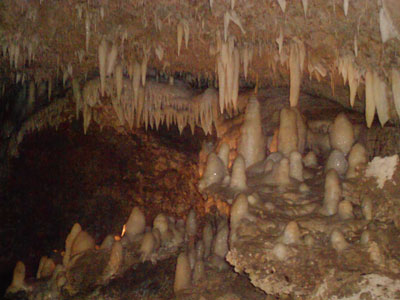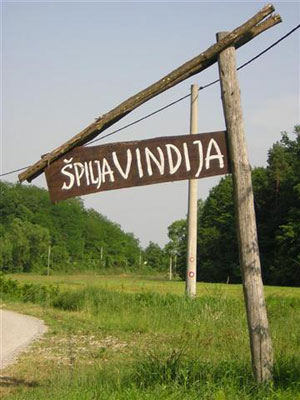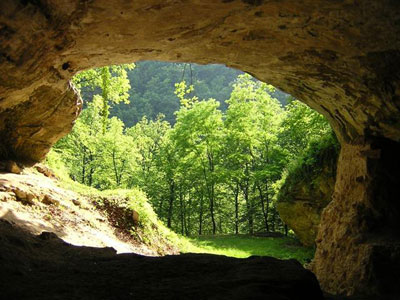Natural caves worth visiting
We asked subscribers to write in about any impressive or historical natural caves worth visiting that are outside of the USA. We asked for the cave’s name and location and when you were there. In addition to describing the place and telling what you found noteworthy about it, we wanted to know how accessible it was plus any visitor restrictions or requirements, the best time to visit, any entry fee, etc., and about interesting sights nearby. We printed a number of responses last month, and here are a few more.
I visited Harrison’s Cave (Welchman Hall, St. Thomas, Barbados; phone, in the US, 246/417-3700, fax 246/417-3709), located in the uplands of the West Indies island of BARBADOS, on Nov. 14, 2011.
This cave was first visited in 1795, but it wasn’t until nearly 200 years later that extensive exploration and surveying were done by a speleologist named Ole Sørensen. It was opened to the public in 1981 and now is Barbados’ number-one tourist attraction.
Harrison’s Cave is a spectacular crystallized limestone cavern filled with stalactites and stalagmites, which you see from an electric tram. In some places the stalactites reach down to join the stalagmites, forming a pillar. There are thousands of these. There are also waterfalls, underground streams and beautiful clear, nearly emerald-green pools of water.
The caves were formed by water erosion through the limestone rock. The dripping of calcium-rich water then formed the stalactites and stalagmites.
Among the caves there is the Great Hall, over 100 feet in height, and The Village, with formations formed over thousands of years. The tram allows you to get off and take photos and to get up close to the formations. Listening to the drip-drip-drip of the calcium-rich water in the silence of the cave was awesome and gave me goose bumps.
You enter through a reception/ticket area and descend via elevator to the cave’s entrance and trams. It takes the tram about 40 minutes to go through the caves along extensive pathways. There are restrooms, a refreshment area and an exhibit of Amerindian artifacts excavated from various sites on Barbados. It’s all open 9 to 4 daily.
The entry fee is approximately $10, but I paid for it in an excursion from the cruise ship Celebrity Summit.
Sharon VanDewark, San Diego, CA
While visiting ISRAEL for a week in 1999, I joined a day tour going to Haifa and south of that city to the border with Lebanon. This allowed us to reach Rosh HaNikra and its grottoes. This is a succession of beautiful small caves on the Mediterranean, each of which allows for wonderful pictures of the blue sea. We walked into the largest of the sea caves.
Since I visited this site, a cable car has been installed to take people down to the grottoes. At a 60-degree angle, it reportedly provides the steepest descent of such vehicles in the world.
There is a promenade suitable for casual walking which allows views of the sea as well as of historic sights, including the area used in WWII.
Philip H. De Turk, Pinehurst, NC
I took a trip to visit the thermal spa resort Băile Felix, about five miles south of Oradea, ROMANIA, Sept. 24-Oct. 3, 2012. The spa treatments were not offered on weekends, so on a Sunday I opted to visit Peştera Urşilor, or Bears’ Cave.
The caves are located near Chis¸cau in Bihor County, about 100 kilometers south of the Hungarian border (or about 85 kilometers southeast of Oradea and 380 kilometers north of Bucharest).
At the concierge desk of the Termal Hotel-Băile Felix (www.hotel-termal.ro [in Romanian]), there was a stack of ads for local tours, including one for a visit to the Bears’ Cave with Transilvania Travel (Termal Hotel-Băile Felix, BH 417500, Romania; phone +40 259 318 191, fax +40 359 800 502, email gabriela.bortos@transilvaniantravel.com or visit www.transilvaniatravel.com). (When I recently visited the website [in Romanian], I found no mention of a Bears’ Cave tour.)
The tour with Transilvania Travel cost RON40 (near $12). Allow another RON40 or so for lunch. (One also could visit the caves on his own without taking a formal tour.)
I was picked up at 10 a.m. in front of the hotel/spa and driven south through the countryside for about two hours. We had a 2- to 3-hour stay at the Bears’ Cave (admission, RON15). The guide was bilingual and in very good English gave an explanation for the three of us who did not understand Romanian.
There was a charge of RON25 ($7) to take photos. Instead, later I bought the comprehensive, 83-page book (with many color pictures) for RON10.
A karst formation at an altitude of 482 meters, Peştera Urşilor gets its name from the numerous fossils of early cave bears (Ursus spelaeus), a typical mammal during the last glaciation in Europe and extinct now for perhaps 24,000 years. In the cave are the fossils of 140 bears that had become trapped inside due to an earthquake.
Discovered in 1975 by a marble-quarry miner following dynamiting work, the caves were opened to the public in 1980. There are impressive stalactites and stalagmites.
The cave’s interior shape was formed by an underground river. The north-to-south length of the cave runs 1.5 kilometers horizontally, except for a 15-meter vertical climb between the two levels of galleries. The lower, 700-meter-long gallery is destined for scientific research.
Visitors are allowed in three upper galleries (450 meters long). The Bone Gallery (140 meters long by 2.5 meters wide by 5 meters high), with numerous lairs, contains 1,500 pieces, including some 140 skulls. Scratches can be seen on 73 circular hollows, or “nests,” used by female cave bears before and after giving birth.
Emil Racovitza Gallery (230x15x10m) contains rich and diversified calcite flowstones, domes and water pools as well as the skeleton of a female cave bear.
There are also bones of other species: ibex, cave lion, cave hyena, wolf, fox, deer, bat, mouse, mole, badger and polecat. The finding of bone deposits in caves is considered rare.
The Candle Gallery is named after its hundreds of tall, slender and “white” stalagmites. True white is an unusual color for most caves. The whiteness found here is due to the pureness of the marble. These naturally sculpted “statues” reflect in the crystal water of the basins.
• After a 3-hour stay in the little town of Chis¸cau, we drove to Saritoarea Bohodei, a 96-meter-high waterfall. We all climbed the rocks and filled our personal water bottles. There were several water-bottling plants nearby.
We also visited the ethnographic museum of Horea & Aurel Flutur, where — arranged on the grounds and in a peasant farmhouse — there are more than 2,500 industrial, agricultural, home, religious and military implements plus room interiors and folk costumes.
Further, we went through Stâna de Vale, a ski-and-spa resort at an altitude of 1,100 meters in the Apuseni Mountains.
Fran White, Lincoln, CA
When discussing caves, most people think of spelunking, but my daughter, Meredith, and my husband, Dennis, and I think “Neanderthal” when we look for caves to visit.
There are two caves in CROATIA that really stand out in our minds as representative of where and how Neanderthals lived. The first one, on the Slovenian border about 34 miles northeast of Zagreb, is called Krapina. While you can’t go into the cave, what’s around it is a must for learning about Neanderthals.
The Krapina semi-cave was first excavated in 1899 when many fossilized bones were discovered. The cave roof collapsed, so you can’t actually enter, but the site has marked paths with sculptures that show the flora and fauna of the area during the Stone Age. There is a world-class museum on the site and a lovely café where you can sit outdoors in the woods, as we did in spring 2008.
The second cave, north of Krapina and near the city of Varaždin, Croatia, is called Vindija, and it is thought that Neanderthals lived in it over 30,000 years ago. The cave has given us the first DNA from Neanderthals; it was recovered from a thighbone, with the sequencing completed in 2010.
Vindija cave is off the beaten path. While looking for it, we thought we were lost. We decided to turn around in a clearing, and there we found the trail to the cave. But it cannot be emphasized enough the beauty you will be taken through while getting there. You’ll see ambling streams, sun-dappled woodland and rustic dwellings. Well worth the trip!
The trailhead to the cave is quaintly marked by a simple wooden sign and a small parking lot across the street. After a short, level hike, the trail turns 180 degrees and bends steeply, guiding you up to the cave. There you will find a cleaned-out rock shelter where the bones were found. You’ll easily be able to time travel back to when our hominid cousins used it.
The cave is easy to walk into, even though the flooring surface is uneven. Good walking shoes and a flashlight are musts.
If readers want to find Neanderthal caves that are easier to get to, there are quite a few in northern Spain, southern France and southern Germany.
Lee Hanle Younge, Big Flats, NY
Our Volkssport walking club (American Volkssport Association) visited Postojna Cave (Jamska cesta 30 6230 Postojna, Slovenia; phone ++386 5 700 01 00), near the town of Postojna, SLOVENIA, in September ’12.
The cave is absolutely huge. You take an electric train several kilometers down into the cave, which has fantastic formations and huge rooms. You then follow footpaths through some of the magnificent formations before returning to the train in another location for your exit.
The cave stretches over 21 kilometers, but only six kilometers of it are accessible to the public. The first record of the cave dates to 1226. From early days, concerts were held in some of the large rooms, and royalty of many countries has visited as well.
I was with a group so don’t know the admission fee, but the cave is open year-round.
Nearby is Predjama Castle, which is located at the entrance to another cave and has quite an interesting story as well.
Ardith Ortgies, Des Moines, IA
Located about 34 miles from SLOVENIA’s charming capital, Ljubljana, is Postojna Cave. Not heavily advertised (by American standards, anyway), this unassuming attraction was a pleasant surprise for my husband, Ray, and me on a visit in March ’07 (admission, €22.90 [near $30]).
More than five kilometers of the 20-kilometer tunnel system are accessible to the public. A small open train takes one through the first two kilometers, and then another three kilometers or so can be explored on foot. The paths are smooth and well lit, with handrails for support. We are senior travelers and did not find this excursion difficult or strenuous. The caves are lovely and locally popular.
A highlight that sets these caves apart from others we’ve visited are the olms, strange amphibians that have made this cave their home for centuries. They are colorless and have no eyes, since they live in total darkness. They have a life span of about 60 years. It is both a fascinating and an eerie experience to see them.
Surprises like these caves continue to remind us that traveling can be an exciting adventure in the most unexpected places.
Barbara Pry, Ringwood, NJ



